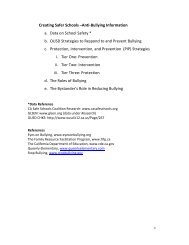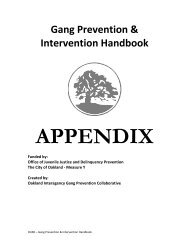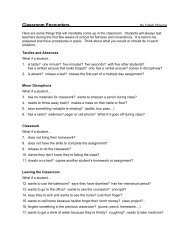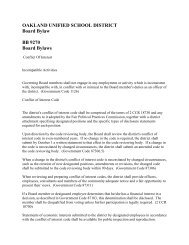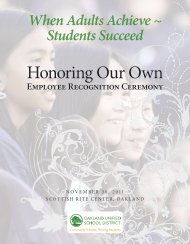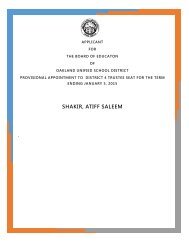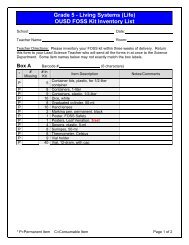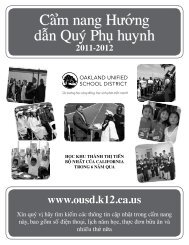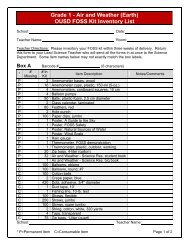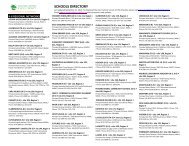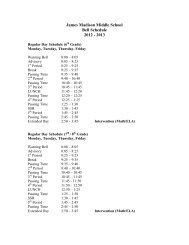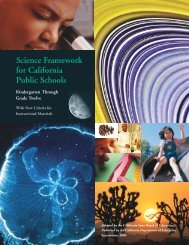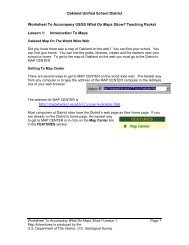Oakland Unified School District Case Study
Oakland Unified School District Case Study
Oakland Unified School District Case Study
Create successful ePaper yourself
Turn your PDF publications into a flip-book with our unique Google optimized e-Paper software.
her to focus more on instruction. It is also<br />
important that Kean has been able to pay<br />
for full preparation periods for the teachers,<br />
which provides them with time to work<br />
with the coaches. In 2008-09, the number<br />
of coaches is pared down, but the coaches<br />
played an instrumental role in leading<br />
change this past year. For example, the<br />
staff relied heavily on its literacy coach,<br />
Flynn, to move the instructional program<br />
of the school toward using standards-based<br />
assessments.<br />
Flynn has been focused primarily on aligning<br />
AWE’s instructional program to the<br />
CST’s. Flynn was formerly a member of the<br />
AWE staff and had moved to Lighthouse<br />
Community Charter <strong>School</strong> as part of her<br />
administrative internship for the NLNS<br />
program. At Lighthouse she worked with<br />
a grade-level team to increase the number<br />
of students proficient in ELA. She worked<br />
with two teachers who were responsible for<br />
40 students and increased the number of<br />
proficient students from 19% to 59%.<br />
Kean invited Flynn to return to AWE<br />
to play a similar role as a literacy coach.<br />
Spurred by the impressive results of her<br />
“test case” at Lighthouse, Flynn conducted<br />
a workshop for teachers focused on surfacing<br />
what it means to be a proficient reader<br />
and what students should be doing by the<br />
end of fifth grade. Many teachers were<br />
inspired by the workshop and felt a sense<br />
of relief at being released from strict adherence<br />
to district curricula, but there was also<br />
resistance. As Flynn recounts:<br />
As a result of being in compliance<br />
mode, teachers had become decapacitated<br />
about their own learning<br />
about how to teach reading, so we<br />
couldn’t just take that away. It took<br />
a lot of work on my part, being in<br />
classrooms, modeling, giving feedback,<br />
and providing them with the<br />
materials they needed to make it<br />
happen. We tried to match up expectations<br />
with support; nonetheless,<br />
this first year was very stressful.<br />
Teachers agree that the change has been<br />
a lot of work, but feel that Flynn’s coaching<br />
has enabled them to implement the<br />
necessary changes in their curriculum and<br />
instructional practice to supplement Open<br />
Court.<br />
The literacy coach is also credited with<br />
organizing effective professional development<br />
activities and facilitating useful sessions<br />
during the weekly teacher collaboration<br />
time. Flynn organizes the professional<br />
development sessions around the gaps<br />
she notices in teacher practice during her<br />
observation time, her assessment of their<br />
instructional plans, and the documents<br />
teachers create. She estimates she spends<br />
70% of her day observing teacher practice.<br />
She and Kean are currently working to create<br />
a framework for a professional learning<br />
community that allows teachers to identify<br />
strengths and challenges and elicit teacher<br />
support.<br />
Although much success is attributed to the<br />
site-based coaching, Kean also highlighted<br />
a session led by OUSD Chief Academic Officer<br />
Brad Stam that was particularly useful<br />
in moving the school in the right direction.<br />
Stam and his colleagues visited the school<br />
to hear and observe what the school was<br />
working on. After observing the instructional<br />
practice throughout the school, Stam<br />
facilitated a fish bowl activity about the<br />
observed practice that was especially effective.<br />
The activity provided an opportunity<br />
for probing questions that fostered deep<br />
discussion around effective instructional<br />
16<br />
<strong>School</strong> Redesign Network at Stanford University



